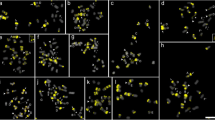Abstract
Citrus sinensis chromosomes, although small in size, present a remarkable differentiation of bands with the fluorochromes CMA and DAPI. These bands suggest that some heteromorphisms are fixed in this species. To investigate the extension of these heteromorphisms, ten cultivars of C. sinenesis were analysed with CMA/DAPI staining and, in some of them, the 18S–5.8S–25S rRNA and 5S rRNA genes were located by in situ hybridization. CMA/DAPI staining showed exactly the same CMA+/DAPI− banding pattern for all cultivars. In situ hybridization revealed three 18S–5.8S–25S rRNA gene sites, two proximally located on two similar chromosomes and one terminally located on a third non-related chromosome. Two 5S rRNA gene sites were observed in this species, with one located proximal to the telomeric 18S–5.8S–25S rDNA site. Both cytological approaches revealed an invariable, heterozygotic karyotype among sweet orange cultivars. Based on these data, the putative hybrid origin of the species is discussed.
Similar content being viewed by others
Author information
Authors and Affiliations
Additional information
Received: 9 April 1999 / Accepted: 22 June 1999
Rights and permissions
About this article
Cite this article
Pedrosa, A., Schweizer, D. & Guerra, M. Cytological heterozygosity and the hybrid origin of sweet orange [Citrus sinensis (L.) Osbeck]. Theor Appl Genet 100, 361–367 (2000). https://doi.org/10.1007/s001220050047
Issue Date:
DOI: https://doi.org/10.1007/s001220050047




